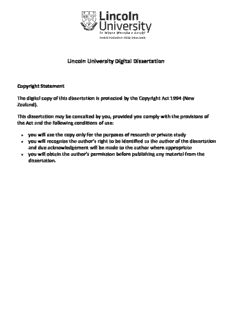
Biological processes for the reduction of alcohol in wines PDF
Preview Biological processes for the reduction of alcohol in wines
Lincoln University Digital Dissertation Copyright Statement The digital copy of this dissertation is protected by the Copyright Act 1994 (New Zealand). This dissertation may be consulted by you, provided you comply with the provisions of the Act and the following conditions of use: you will use the copy only for the purposes of research or private study you will recognise the author's right to be identified as the author of the dissertation and due acknowledgement will be made to the author where appropriate you will obtain the author's permission before publishing any material from the dissertation. BIOLOGICAL PROCESSES FOR THE REDUCTION OF ALCOHOL IN WINES A dissertation submitted in partial fulfilment of the requirements for the Degree of Master of Applied Science at Lincoln University by P.M. Smith Lincoln University 1995 Abstract of a dissertation submitted in partial fulfilment of the requirements for the Degree of M. App!. Sc. BIOLOGICAL PROCESSES FOR THE REDUCTION OF ALCOHOL IN WINES by P.M. Smith Key words: aeration, sugar and alcohol reduction, temperature, selected yeast strains, sensory suitability, combined aerobic/anaerobic fennentation, oxidation A study wa<; conducted into the effect of varying levels of aeration and temperature on the reduction of sugar and production of alcohol in Muller Thurgau grape juice by selected yeast strains. In addition, an assessment of the suitability of combining aeration with anaerobic fennentation to produce a reduced alcohol wine with acceptable colour and taste was undertaken. Of seven yeast strains which had shown promising results at reducing sugar levels in either apple juice or orange juice, three; Pichia stipitis, Candida tropicalis and Saccharomyces cerevisiae, individually produced significant e alcohol reductions when fennented at 30D under controlled aeration. By combining short-tetID controlled aeration, to reduce the sugar content of the grape juice, with anaerobic fennentation using an active dried wine yeast, wines with acceptable taste and 25 to 30% less alcohol were produced. These wines did, however, exhibit the deep golden colour indicative of oxidation. ii ACKNOWLEDGEMENTS I wish to express thanks to my supervisor, Dr. Mike Noonan, for his support throughout the course of my study, and to my associate supervisor, Dr. David Heatherbell. Thanks are also extended to Leo Vanhanen and Andrea Coop for their assistance in preparation of reagents and help with laboratory know how. iii TABLE OF CONTENTS PAGE ABSTRACT i ACKNOWLEDGEMENTS ii TABLE OF CONTENTS iii- viii LIST OF FIGURES AND TABLES ix CHAPTER 1.0 REVIEW OF LITERATURE 1 1.1 LOW OR REDUCED ALCOHOL BEVERAGES 1 1.1.1 Introduction 1 1.1.2 What are low or reduced alcohol beverages? 2 1.1.3 Why the interest in low alcohol wines? 3 1.1.4 Types of technology commercially available for reducing alcohol in wines 4 and grape must 1.1.4.1 -distillation 4 1.1.4.2 -partial felmentation 5 1.1.4.3 -reverse osmosis 5 1.1.4.4 -spinning cone column technology 5 1.1.4.5 -blends of grape and fruit juice 7 1.1.4.6 -enzymatic treatment of grape juice 9 1.1.4.7 -biological methods 12 iv 1.2 RESEARCH INTO THE REDUCTION OF SUGARS IN FRUIT JUICES USING BIOLOGICAL METHODS 13 1.3 PROPOSED RESEARCH 20 1.4 THE MICRO-ORGANISMS OF WINEMA KING 21 1.4.1 Introduction 21 1.4.1.1 -lactic acid bacteria 21 1.4.1.2 -acetic acid bacteria 22 1.4.1.3 -fungi 22 1.4.1.4 -bacillus & clostridium spp. 23 1.4.1.5 -yeasts 23 1.4.2 Sugar utilisation by yeasts and their requirements for oxygen 23 1.4.2.1 -anaerobic metabolism 24 1.4.2.2 -alcoholic fermentation 25 1.4.2.3 -aerobic metabolism 25 1.4.2.4 -obligate aerobes 27 1.4.2.5 -facultative anaerobes 27 1.4.3 What are the "wine yeasts" and how does the environment affect their growth 28 1.4.3.1 -the principal phases of yeast growth 28 1.4.3.2 -environmental changes 29 1.4.3.3 -temperature 29 1.4.3.4 -oxygen availability 30 v 1.4.4 Batch and continuous culture of yeasts 31 1.4.4.1 -batch growth 32 1.4.4.2 -continuous culture 33 1.4.4.3 -cultivation of yeasts 35 A -batch culture 35 B -continuous culture 39 CHAPTER 2.0 MATERIALS AND METHODS 44 2.1 THE YEASTS 45 2.2 CULTURE TECHNIQUES AND SAMPLE PREPARATION 46 2.2.1 Culture techniques 46 2.2.2 Sample preparation 47 2.3 CHEMICAL METHODS OF SUGAR AND ALCOHOL ANALYSIS IN MUSTS AND WINE 48 2.3.1 Determination of reducing sugar by Rebellein Method 48 2.3.2 Determination of alcohol and sugar with the Combitest Process (Combi method) 49 2.3.2.1 -sugar determination 50 2.3.2.2 -alcohol detetmination 51 vi CHAPTER 3.0 EXPERIMENTAL PROCEDURE 52 3.1 INTRODUCTION 52 3.2 FERMENTATION AT 25°C 52 3.3 CONTINUOUS STIRRED FERMENTATION OF SACCHAROMYCES CEREVISIAE AT 25°C 52 3.4 FERMENTATION AT 30°C 53 3.5 COMBINED AEROBIC/ANAEROBIC FERMENTATION USING SACCHAROMYCES, PICHIA/SACCHAROMYCES AND 53 CANDIDA/SACCHAROMYCES CHAPTER 4.0 RESULTS 55 4.1 FERMENTATION AT 25°C 55 4.2 CONTINUOUS STIRRED FERMENTATION OF SACCHAROMYCES CEREVISIAE AT 25°C 56 4.3 FERMENTATION AT 30°C 57 vii 4.4 COMBINED AEROBIC/ANAEROBIC FERMENTATION USING SACCHAROMYCES, PICHIA/SACCHAROMYCES AND CANDIDA/SACCHAROMYCES 69 CHAPTER 5.0 CONCLUSIONS 76 REFERENCES 78 APPENDICES 84 2.1 Appendix I - Descliption of yeast species 84 2.3.1 Appendix II - Analysis Method - Rebellein 96 2.3.2.2 Appendix III - Preparation of reagents for Combi Test and standardised analysis method 98 4.3 Appendix IV - First 30°C Felmentation 100 4.3.2 - sugar and alcohol during felmentation 4.3.2.1 - P. stipitis 4.3.2.2 - C. tropicalis 4.3.2.3 - S. cerevisiae viii 4.3 Appendix V - Second 30°C fermentation, in duplicate 102 4.3.4 -sugar and alcohol during felmentation 4.3.4.1 - P. stipitis 4.3.4.2 - C. tropicalis 4.3.4.3 - S. cerevisiae 4.3.5 -pH and titratable acidity during felmentation 4.3.5.1 -P. stipitis 4.3.5.2 - C. tropicalis 4.3.5.3 -S. cerevisiae 4.5 Appendix VI -Combined aerobic/anaerobic felmentation 115 4.5.1 - Sugar during fermentation 4.5.2 - Alcohol during fermentation 4.5.3 -Titratable acidity during felmentation 4.5.4 -pH during felmentation
Description: